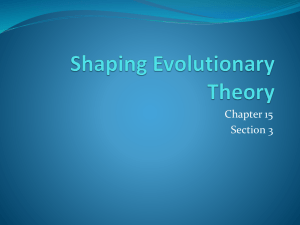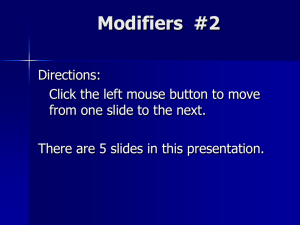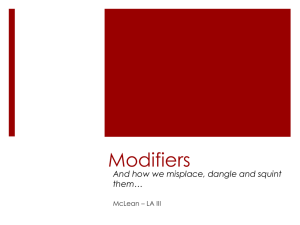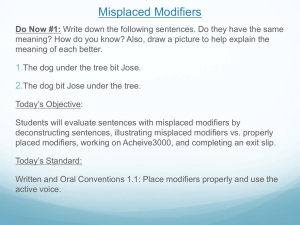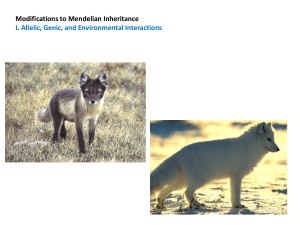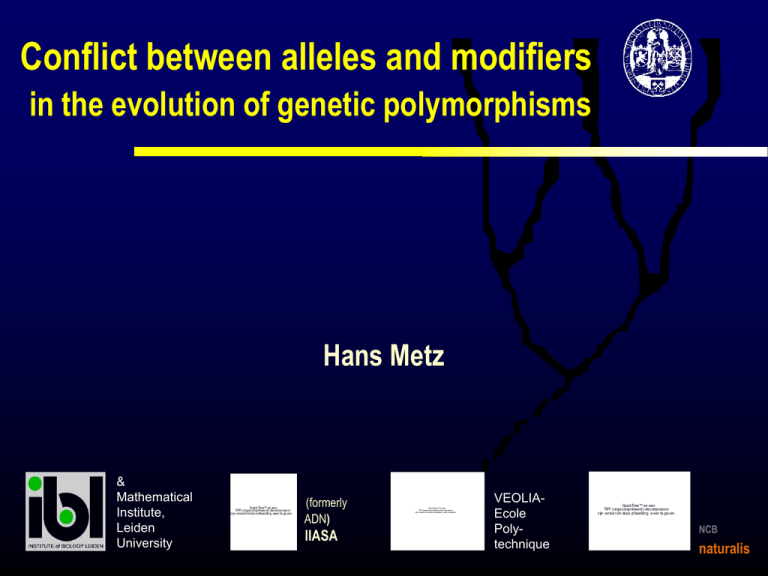
Conflict between alleles and modifiers
in the evolution of genetic polymorphisms
Hans Metz
&
Mathematical
Institute,
Leiden
University
Quick Time™ en ee n
TIFF ( ong ec omprimee rd) -de compr ess or
zijn v ere ist o md ez e a fbee ldin g wee r te ge ven .
(formerly
ADN)
IIASA
QuickTime™ en een
TIFF (ongecomprimeerd)-decompressor
zijn vereist om deze af beelding w eer te geven.
VEOLIAEcole
Polytechnique
QuickTime™ en een
TIFF (ongecomprimeerd)-decompressor
zijn vereist om deze af beelding w eer te geven.
NCB
naturalis
the tool
(Assumptions: mutation limitation, mutations have small effect.)
the canonical equation of adaptive dynamics
with Mendelian reproduction:
dX
2 Ne
dt
C
s X Y
Y
Y X
T
evolutionary
stop
=0
X: value of trait vector predominant in the population
Ne: effective population size, : mutation probability per birth
C: mutational covariance matrix, s: invasion fitness, i.e.,
initial relative growth rate of a potential Y mutant population.
evolutionary constraints
directional
selection
phenotype
genotype
Most phenotypic evolution is probably regulatory, and hence
quantitative on the level of gene expressions.
reading direction
coding region
regulatory regions
DNA
the canonical equation of adaptive dynamics
The canonical equation is not dynamically sufficient
as there is no need for C to stay constant.
Even if at the genotype level the covariance matrix stays constant,
the non-linearity of the genotype to phenotype map
will lead to a phenotypic C that changes
with the genetic changes underlying the change in X.
additional (biologically unwaranted) assumption
I only showed (and use)
the canonical equation for the case of
symmetric phenotypic mutation distributions
saving grace?
I have reasons to expect that my final conclusions are
independent of this symmetry assumption,
but I still have to do the hard calculations to check this.
the canonical equation of adaptive dynamics
s X Y
dX
2 Ne C
dt
Y
Y X
dX
N
2
dt
Ts e2
C
Tr N
Ne
Ts 2e
R0 X Y
Y
Y X
sX Y
R0 :
average life-time offspring number
Ts :
average age at death
average age at reproduction
T
ln R0 X Y
e2 : effective variance of life-time offspring number
Tr :
T
Tr
of the residents
of the residents
CE is derived via two subsequent limits
individual-based
stochastic process
canonical equation
limit
branching
t
trait value
limit type:
system size ∞
successful mutations/time 0
mutational step size
0
this talk: evolution of genetic polymorphisms
individual-based
stochastic process
canonical equation
limit
branching
t
trait value
limit type:
system size ∞
successful mutations/time 0
mutational step size
0
the ecological theatre
Assumptions: but for genetic differences individuals are born equal,
random mating, ecology converges to an equilibrium.
equilibria for general eco-genetic models
For a physiologically structured population
with all individuals born in the same physiolocal state,
mating randomly with respect to genetic differences,
the equilibria can be calculated by
(1) setting the average life-time offspring number over
the phenotypes equal to 1,
(2) calculating the genetic composition of the birth
stream from equations similar to the classical
(discrete time) population genetical ones,
with those life-time offspring numbers as fitnesses.
the eco-genetic model
Organism with a potentially polymorphic locus with two segregating
alleles, leading to the phenotype vector X G , with G aa, aA, AA.
X : Xaa
E:
XaA
XAA
T
instantaneous ecological environment
(XG ; E) : expected expected per capita lifetime macrogametic output
(= average number of kids mothered)
(XG ; E): expected per capita lifetime microgametic output times
fertilisation propensity
( average number of kids fathered)
Abbreviations: G : (XG ; E), etc. (and similar abbreviations later on).
the eco-genetic model
C = classical discrete time model
B:
total birth rate density
(C: total population density, N)
pa , pA, qa , qA : allelic frequencies in the micro- resp. macro-gametic outputs
( pa 1 pA and qa 1 qA )
baa ,baA ,bAA : genotype birth rate densities (C: genotype densities, naa, etc)
random union of gametes:
baa pa qa B,
baA ( pAqa pa qA )B,
Point equilibria:
with
bAA pAqA B.
qA naaAApTAs,aa
qAbaa, 12etc.
aA (pAqa paqA ),
pA AA pAqA 12 aA (pAqa paqA ),
: pAqAAA (pAqa paqA )aA paqaaa 1,
: pAqA AA ( pAqa pa qA )aA pa qa aa .
example ecological feedback loop: E F 1 (E, XG )nG , ... , k (E, XG )nG
G
G
the evolutionary play
Assumptions: no parental effects on gene expressions
(mutation limitation, mutations have small effect)
long term evolution
Two models
I. Evolution through allelic substitutions
Xa , XA : allelic trait vectors
:
genotype to phenotype map: XaA (Xa , XA ), etc.
Abbreviations:
(Xa , X A )
: 1(Xa , X A ) : 1aA ,
Xa
etc.
II. Evolution through modifier substitutions
b : original allele on generic modifier locus,
X aa Xbb,aa
XbB,aa
B: mutant, changing X XaA Xbb,aA : Xb into XbB,aA : X B .
X AA Xbb, AA
XbB, AA
smooth genotype to phenotype maps
Model I (allelic evolution)
If X XA Z A then
Xa XaA 2aA ZA O( 2 ),
XA XAA 2AA ZA O( 2 ),
X XAA 1AA ZA 2AAZA O( 2 ) XAA 2 2AA ZA O( 2 )
Model II (modifier evolution)
XbB,aa Xbb,aa
X BB,aa Xbb,aa
Z aa
Z aa
2
If XbB,aA Xbb,aA Z aA then X BB,aA Xbb,aA 2 Z aA O( )
X
X
X
X
Z AA
Z AA
bB, AA
bb, AA
BB, AA
bb, AA
Model I: phenotypic change in the CE limit
with
dX a
0
21 aa dt
dX dX dX
dX a
dX A
1 aA
2 aA
dt dt a dt A
dt
dt
dX A
0
2 2 AA dt
R0, Xa XA (X )
R0, Xa XA (X )
dX A
dXa
A N A 2 AC A
a N a 2 aCa
,
X
dt
X
a dt
A
T
with
a 2 (Ts,a a2 ), A 2 (Ts,A A2 ),
a , A the mutation probabilities per allele per birth,
C a , C A the mutational covariance matrices,
and
a : 12 (pa qa ), A : 12 (pA qA ).
T
Model I: phenotypic change in the CE limit
R0.Xa XA (Xa )
Xa
R0, Xa XA (XA )
XA
R0, Xaa , XaA , XAA (Xaa , XaA )
Xaa
R0, Xaa , XaA , XAA (XAA , XaA )
XAA
1aa
2 AA
R0, Xaa , XaA , XAA (Xaa , XaA )
XaA
1aA
R0, Xaa , XaA , XAA (XAA , XaA )
XaA
2 aA
Convention:
Differentiation is only with respect to the regular arguments, not the indices.
notation
denotes the Kronecker product:
a11B L
AB M
am1B L
a1n B
M
amn B
and
I the identity matrix of any required size
Model I: phenotypic change in the CE limit
in matrix notation:
structure
matrix
0 dX
1 aa
a
2 0 0 0
0 dt
dX
1 aA
0 1 1 0 I
2 aA dX A
dt
0
0 0 0 2
0
2 AA dt
and (the allelic coevolution equations)
dXa
T
0
%a%a aCa
1aaT 1aA
dt
0
N
2
allelic
allelic
T
% C 0
dX
%
0
0
A
2
aA
A
A
A
A
dt
with
allelic a a A A ,
%a a allelic ,
R0, X , X , X (Xaa , XaA ) T
aa aA AA
X
aa
T
R
(X
,
X
)
0, Xaa , XaA , X AA
aa
aA
XaA
0
T
T
2 AA R
0, Xaa , XaA , X AA (X AA , X aA )
X
aA
T
R
(X
,
X
)
0, Xaa , XaA , XAA AA aA
X AA
allelic aa A A ,
%A A allelic ,
%a a allelic ,
%A A allelic .
Model I: phenotypic change in the CE limit
combining the previous results gives:
dX
allelic N
dt
2
0
0
0 0 0
1 1 0
0 0 2
I 2 allelic C allelicGallelic
with
and
%a%
0
0
0
a a
0
%a%
0
0
a a
I
:
0
0
%A%
0
A A
0
0
%A%
0
A A
1 aa
1 aA
C allelic :
0
0
0
0 Ca
2 aA 0
2 AA
T
0 1 aa
C A 0
T
1 aA
0
0
T
2 aA
0
T .
2 AA
Model I: phenotypic change in the CE limit
with
Gallelic
R0, X , X , X (X aa , X aA ) T
aa
aA
AA
X
aa
T
R
(X
,
X
)
0, Xaa , XaA , X AA aa aA
X aA
T
R0, X , X , X (X AA , X aA )
aa
aA
AA
X aA
T
R0, Xaa , XaA , X AA (X AA , X aA )
X
AA
Model I: phenotypic change in the CE limit
an explicit expression for the allelic (proxy) selection gradient:
Gallelic Ê B1 ÊGcommon
with
a 0 0 0
0 0 0
a
I
B
0 0 A 0
0 0 0
A
on the Hardy-Weinberg manifold (pA = qA) :
I
aa aA aA aa
AA aA aA AA
a ÊÊÊ1 ( pa qa )
,ÊÊÊÊ A ÊÊÊ1 ( p A q A )
4
4
4
4
Model I: phenotypic change in the CE limit
Gcommon
aA
pa
2
p aa
A 2
p AA
a 2
aA
p A 2
aa
aa
aA
pA qA
qA pA
qa
2
2X aa
2 X aa
T
T
aA
aa
aA
pa qa
q
q
p
A
a
a
2
2X aA
2 X aA
T
T
aA
aA
AA
pA qA
qA pA
qa
2
2X aA
2 X aA
T
T
AA
AA
aA
pa qa
qa pa
qA
2
X
2
2
X
AA
AA
T
aa (Xaa ;EXaa XaA XAA ), etc.
with
effect a mutation in the
and
a
pa--allele
qaaa (paqA pAqa )aA Ap-allele
AqAAA 1
T
Model I: phenotypic change in the CE limit
Gcommon
aA
pa
2
p aa
A 2
p AA
a 2
aA
p A 2
aa
aa
aA
pA qA
qA pA
qa
2
2X aa
2 X aa
T
T
aA
aa
aA
pa qa
q
q
p
A
a
a
2
2X aA
2 X aA
T
T
aA
aA
AA
pA qA
qA pA
qa
2
2X aA
2 X aA
T
T
AA
AA
aA
pa qa
qa pa
qA
2
X
2
2
X
AA
AA
T
(Xaachange
;EAX=aa XqaAAinX)AAthe
), etc.
with
effect
the resulting phenotypic
on
theofHardy-Weinberg
(p
aamanifold
and
heterozygotes 2 AA-homozygotes
aa-homozygotes
pqp2
(pq2ppp q )
p p q 1 1
a a aaa
aa a A a
a
AA aA
aA A
AAA A
AA
T
summary of Model I (allelic trait substitution)
on the Hardy-Weinberg manifold:
2 0 0 0
dX
allelic N 0 1 1 0 I 2allelic Callelic B1 Gcommon
0 0 0 2
dt
Gcommon
pa aA
2
p aa
A 2
p AA
a 2
aA
p
A 2
T
T
aa
aA
aa
pA qA
qA pA
qa
2
2X aa
2 X aa
T
T
aA
aA
aa
pa qa
qa pa
qA
2
2X aA
2 X aA
T
T
aA
aA
AA
pA qA
qA pA
qa
2
X
2
2
X
aA
aA
T
T
AA
AA
aA
pa qa
qa pa
qA
2
X
2
2
X
AA
AA
Model II: phenotypic change in the CE limit
dX
2 modifier N 2 haplotype CmodifiersGmodifier
dt
2
2
(T
with modifier
s,modifier modifier ) , haplotype the mutation probability per
haplotype per birth, Cmodifiers the covariances of the mutational effects of
modifiers.
Gmodifier
1
0
0
0 0 0
1 1 0
0 0 1
with
on the Hardy-Weinberg manifold:
I ÊGcommon
a 0 0 0
0
0
0
1
ÊÊ a A A a a 0 a 0 0 I
0 0 0 0 A 0 0
I
ÊÊÊÊÊÊ:Ê 0 a 0 0
0 0
A
0
A
aA
aA
aA
aA
a ÊÊqa
pa
1 A ,Ê
1 a
0ÊÊÊ 0A 0q A A pA
2
2
2
2
summary: model comparison
Model I (allelic substitutions):
dX
allelic N
dt
2
0
0
Model II (modifier substitutions):
dX
2 modifier N 2 haplotypeC modifiers
dt
Gcommon
qa aA
2
q aa
A 2
q AA
a 2
aA
q A 2
0 0 0
1 1 0
0 0 2
1
0
0
I 2 allelic C allelic B1Gcommon
0 0 0
1 1 0
0 0 1
I
Gcommon
T
T
aa
aA
aa
qA pA
pA qA
pa
2
X
2
2
X
aa
aa
T
T
aA
aA
aa
qa pa
p
p
q
A
a
a
2
2 X aA
2X aA
T
T
aA
aA
AA
qA pA
pA qA
pa
2
2 X aA
2X aA
T
T
AA
AA
aA
qa pa
p qa
pA
2 a
2 X AA
2X AA
summary: model comparison
Model I (allelic substitutions):
dX
allelic N
dt
2
0
0
Model II (modifier substitutions):
dX
modifier N 2 haplotypeC modifiers
dt
Gcommon
qa aA
2
q aa
A 2
q AA
a 2
aA
q A 2
0 0 0
1 1 0
0 0 2
2
0
0
I 2 allelic C allelic B1Gcommon
0 0 0
2 2 0
0 0 2
I
Gcommon
T
T
aa
aA
aa
qA pA
pA qA
pa
2
X
2
2
X
aa
aa
T
T
aA
aA
aa
qa pa
p
p
q
A
a
a
2
2 X aA
2X aA
T
T
aA
aA
AA
qA pA
pA qA
pa
2
2 X aA
2X aA
T
T
AA
AA
aA
qa pa
p qa
pA
2 a
2 X AA
2X AA
on the Hardy-Weinberg
manifold
summary: model comparison
Model I (allelic substitutions):
dX
allelic N
dt
2
0
0
Model II (modifier substitutions):
dX
modifier N 2 haplotypeC modifiers
dt
Gcommon
qa aA
2
q aa
A 2
q AA
a 2
aA
q A 2
0 0 0
1 1 0
0 0 2
2
0
0
I 2 allelic C allelic B1Gcommon
0 0 0
2 2 0
0 0 2
I
Gcommon
T
T
aa
aA
aa
qA pA
pA qA
pa
2
X
2
2
X
aa
aa
T
T
aA
aA
aa
qa pa
p
p
q
A
a
a
2
2 X aA
2X aA
T
T
aA
aA
AA
qA pA
pA qA
pa
2
2 X aA
2X aA
T
T
AA
AA
aA
qa pa
p qa
pA
2 a
2 X AA
2X AA
summary: model comparison
2
0
0
2 haplotypeC modifiers
0 0 0
1 1 0
0 0 2
2
0
0
on the Hardy-Weinberg
manifold
I 2 allelic C allelic
0 0 0
2 2 0
0 0 2
I
summary: model comparison
2
0
0
0 0 0
1 1 0
0 0 2
on the Hardy-Weinberg
manifold
I 2 allelic C allelic
2 haplotypeC modifiers
2
0
0
0 0 0
2 2 0
0 0 2
I
summary: model comparison
2
0
0
0 0 0
1 1 0
0 0 2
on the Hardy-Weinberg
manifold
I 2 allelic C allelic
2 haplotypeC modifiers
2
0
0
0 0 0
2 2 0
0 0 2
I
%a%
0
0
0
a a
0
%a%
0
0
a a
I
:
0
0
%A%
0
A A
%
%
0
0
0
A A A
summary: model comparison
2
0
0
0 0 0
1 1 0
0 0 2
I 2 allelicCallelic
2 haplotypeC modifiers
B
on the Hardy-Weinberg
manifold
2
0
0
0 0 0
2 2 0
0 0 2
A
I
%a%
0
0
0
a a
0
%a%
0
0
a a
I
:
0
0
%A%
0
A A
%
%
0
0
0
A A A
summary: model comparison
Model I (allelic substitutions):
dX
allelic N
dt
2
0
0
Model II (modifier substitutions):
dX
modifier N 2 haplotypeC modifiers
dt
a 0 0 0
0 0 0
a
I
B
0 0 A 0
0 0 0
A
0 0 0
1 1 0
0 0 2
2
0
0
I 2 allelic C allelic B1Gcommon
0 0 0
2 2 0
0 0 2
I
a 0
a
1 0
a A A a
0 0
0 0
Gcommon
0 0
0 0
I
A 0
0 A
aa aA aA aa
AA aA aA AA
a ÊÊÊ1 ( pa qa )
,ÊÊÊÊ A ÊÊÊ1 ( p A q A )
4
4
4
4
a ÊÊqa
aA
pa aA 1 A ,ÊÊÊÊ A qA aA pA aA 1 a
2
2
2
2
in reality alleles and modifiers will both evolve
combining Models I and II:
dX
dt
dX
dX dX
dX
dX
dt modifier dt a dt A
dt modifier dt allelic
evolutionary statics
genetical and developmental assumptions
Cmodifiers uniformly has full rank and C allelic uniformly has maximal rank.
In biological terms: there are no local developmental or physiological
constraints.
When there are developmental or physiological constraints, we can
usually define a new coordinate system on any constraint manifold that
the phenotypes run into, and proceed as in the case without constraints.
So-called genetic constraints are rooted more deeply than in the
physiology or developmental mechanics.
Example: some phenotypes can only be realised by heterozygotes.
IF: There are no constraints whatsoever, that is, any combination of
phenotypes may be realised by a mutant in its various heterozygotes.
(known in the literature as the “Ideal Free” assumption).
evolutionary stops
Evolutionary stops satisfy
I:
2
0
0
0 0 0
1 1 0 I
0 0 2
II:
1
0
0
0 0 0
1 1 0 I
0 0 1
&
1
Callelic B Gcommon 0
Gcommon 0
that is, Gcommon should lie in the null-space of
I:
respectively
II:
2
0
0
0 0 0
1 1 0 I
0 0 2
1
0
0
Callelic B1
0 0 0
1 1 0 I
0 0 1
dCallelic
0
dt
evolutionary stops
Allelic evolution for model I:
dXa
T
T
0
0
dt
1aA
Ca 0 1aa
allelic 2N allelic
T
T Gallelic
2 aA 2 AA
0 CA 0
0
dX A
dt
Gallelic Ê B1 ÊGcommon
Hence at the stops:
T
T
0
0 1
1aA
Ca 0 1aa
Gcommon 0
T
T B
0 C 0
2 aA 2 AA
0
A
or equivalently,
CallelicB1Gcommon 0
when do the alleles and modifiers agree?
The alleles on the focal locus and the modifiers agree about a stop only if
1
C
B
Gcommon 0
I
allelic
and
1 0 0 0
0 1 1 0 I G
II
common 0
0
0 0 1
If the dimensions of phenotypic and allelic spaces are n resp. m, then
I is a system of min{4n, 2m}, II a system of 3n equations.
In the case of modifier evolution, these have to be satisfied by 3n,
in the case of allelic evolution by min{2m,3n} unknowns
(since the Xa , XA act only through the Xaa , XaA , XAA ).
The seemingly simpler Gcommon = 0, amounts to 4n equations.
Hence, generically there is never agreement.
(When 2m > 4n, the alleles cannot even agree among themselves!)
exceptions to the generic case
We have already seen a case where the alleles and modifiers agree:
if pA = qA.
This can happen for two very different reasons:
1. When
(XG ; E) (XG ; E)
(HW)
(the standard assumption of population genetics).
2. Phenotype space can be decomposed (at least locally near the ESS)
into a component that influences only , and one that only influences
(as is the case in organisms with separate sexes),
and moreover the Ideal Free assumption applies.
In that case at ESSes aa = aA = AA = 1 and aa = aA = A.,
Hence (HW) applies, and therefore pA = qA.
inverse problem: find all the exceptions
Assumption:
4m≥ n
In that case there is only agreement at evolutionary stops iff at those stops
Gcommon = 0.
inverse problem: find all the exceptions
For one dimensional phenotype spaces the individual-based restrictions on
the ecological model that robustly guarantee that Gcommon = 0 are that
(a) at evolutionary stops (HW) holds true, or (b) in their neighbourhood:
(i) aA xaA 0ÊÊaA xaA 0 or aA xaA 0ÊÊaA xaA 0
or
(ii) aa xaa 0 & aa xaa 0 or AA xAA 0 & AA xAA 0
If not (a), any individual-based restriction doing the same job implies (b).
Examples: A priori Hardy Weinberg: .
Ecological effect only through one sex: either x 0 or x 0.
Sex determining loci: for AA females and aA males: AA 0, aA 0.
The conditions for higher dimensional phenotype spaces are that after a
diffeomorphism the space can be decomposed into components in which
one or more of the above conditions hold true.
biological conclusions
Olof
Leimar
Quick Time™ e n e en
TIFF ( LZW) -de compr ess or
zi jn v ere ist om dez e a fbe eld ing we er te g ev en.
When the focal alleles and modifiers fail to agree
the result will be an evolutionary arms race
between the alleles and the rest of the genome.
This arms race can be interpreted as
a tug of war between trait evolution and sex ratio evolution.
Generically there is disagreement,
with one biologically supported exception:
the case where the sexes are separate.
(Even though in all the usual models there is agreement!)
Prediction
Hermaphroditic species have a higher turn-over rate of their genome
than species with separate sexes.
QuickTime™ and a
decompressor
are needed to see this picture.
Carolien de Kovel
The end
history
basic ideas and first derivation (1996)
hard proofs (2003)
QuickTime™ en een
TIFF (ongecomprimeerd)-decompressor
zijn vereist om deze afbeelding weer te geven.
Ulf Dieckmann & Richard Law
Mendelian
discrete
diploids
generations
extensions (2008)
QuickTime™en een
-decompressor
zij n vereist omdeze afbeeldi ng weer te geven.
Nicolas Champagnat & Sylvie Méléard
dX
122 N e C
dt
s Y X
Y Y X
hard proof
for pure age
rather unbiological
dependence
T
Michel Durinx & me
general
with
Poisson
life
histories
# offspring
only for
Assumptions
still
(correspondingso
to far
a Lotkanot
yet published
equilibria
Volterra type ODE model): individuals reproduce community
clonally, have
non-rigorous
Tran
exponentially distributed Chi
lifetimes
and give birth at constant
rate
non-rigorous
(2006)
from birth onwards
in reality alleles and modifiers will both evolve
in “reality”:
dX
dt
dX
dX dX
dX
dX
dt modifier dt a dt A
dt modifier dt allelic
Generically in the genotype to phenotype map all three equations are
incomplete dynamical descriptions as , C allelic and C modifier may still
change as a result of the evolutionary process.
C allelic and C modifier are constant when is linear and C a and C A resp.
the C B are constant (two commonly made assumptions!).
Otherwise constancy of C modifier and C allelic requires that changes in
the various composing terms precisely compensate each other.
rarely will be constant as a and A generically change with
changes in X.
the canonical equation of adaptive dynamics
dX
2 ne C
dt
s Y X
Y Y X
T
X: value of trait vector predominant in the population
ne: effective population size, : mutation probability per birth
C: mutational covariance matrix, s: invasion fitness, i.e.,
initial relative growth rate of a potential Y mutant population.

